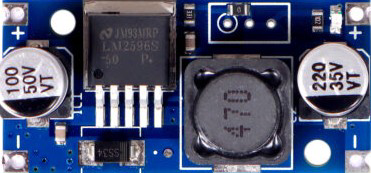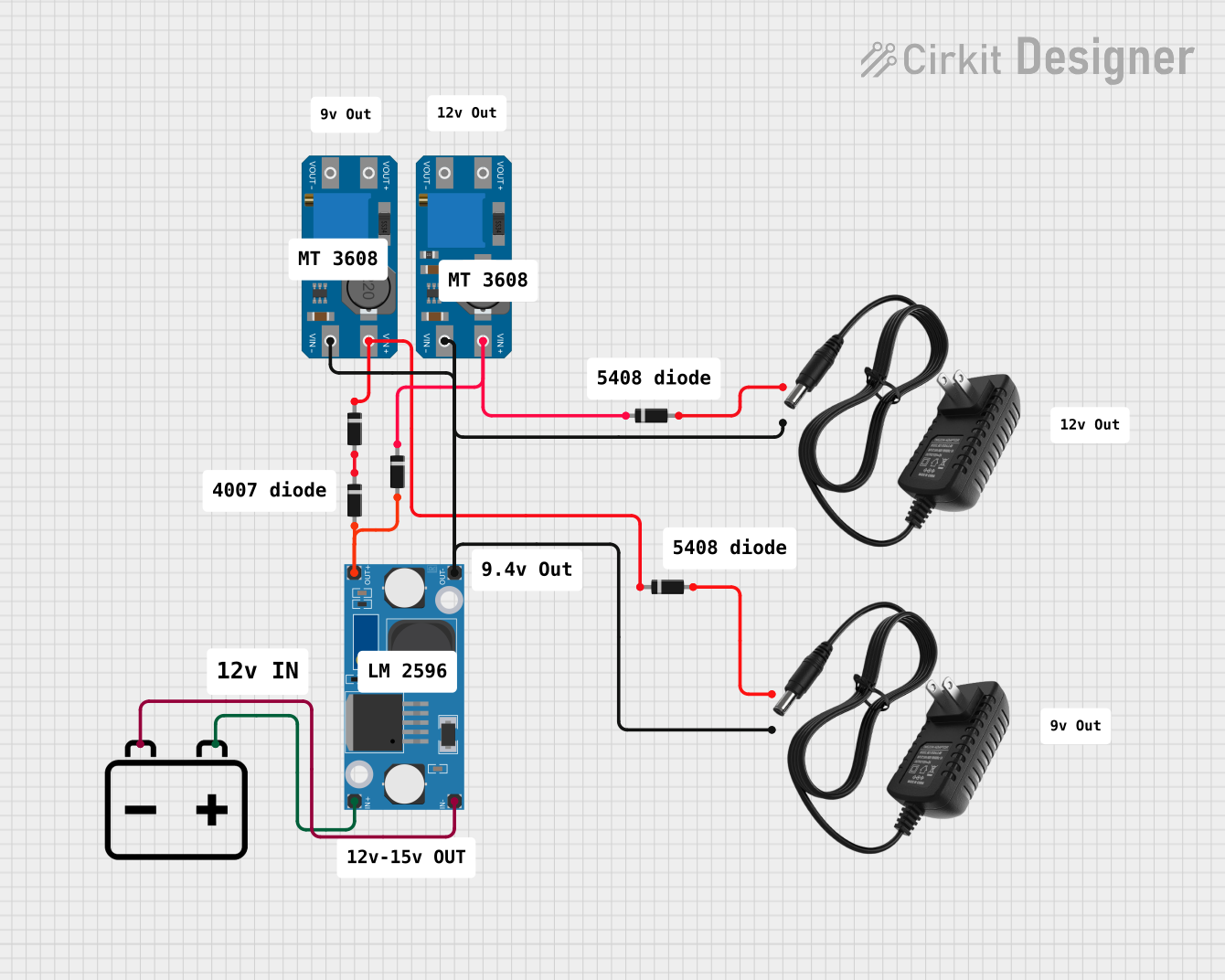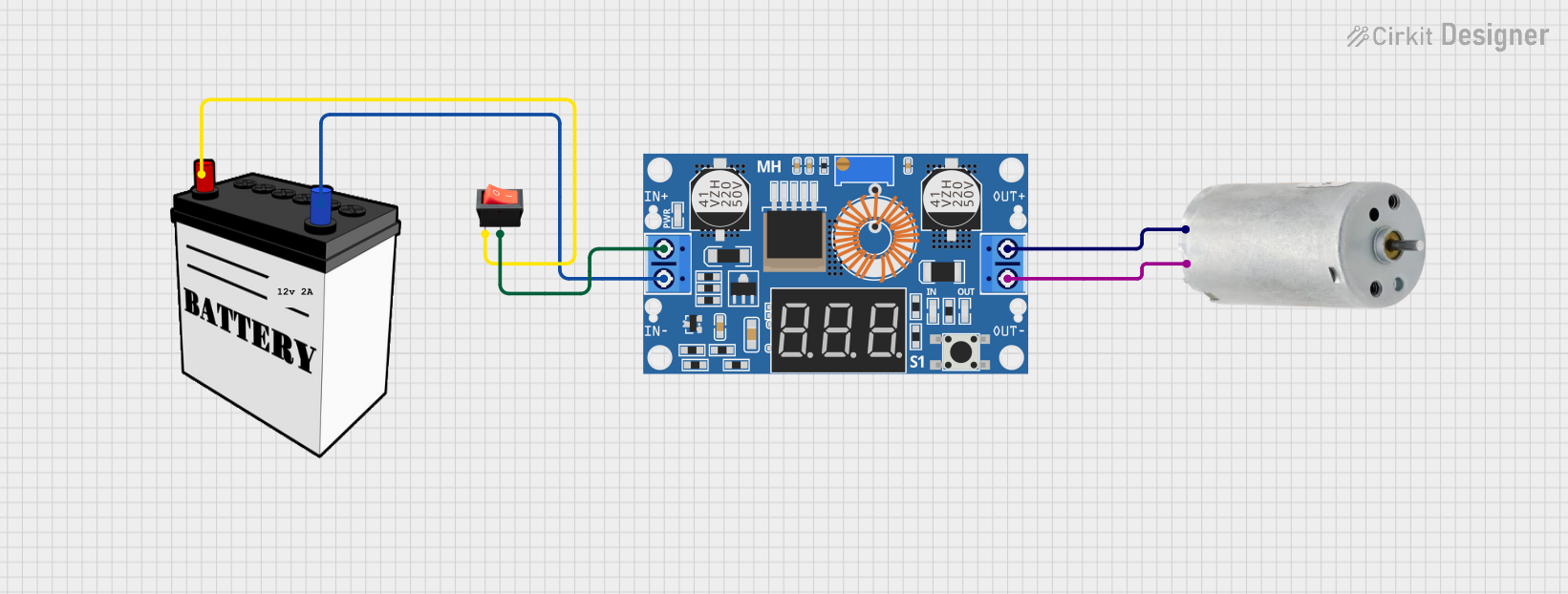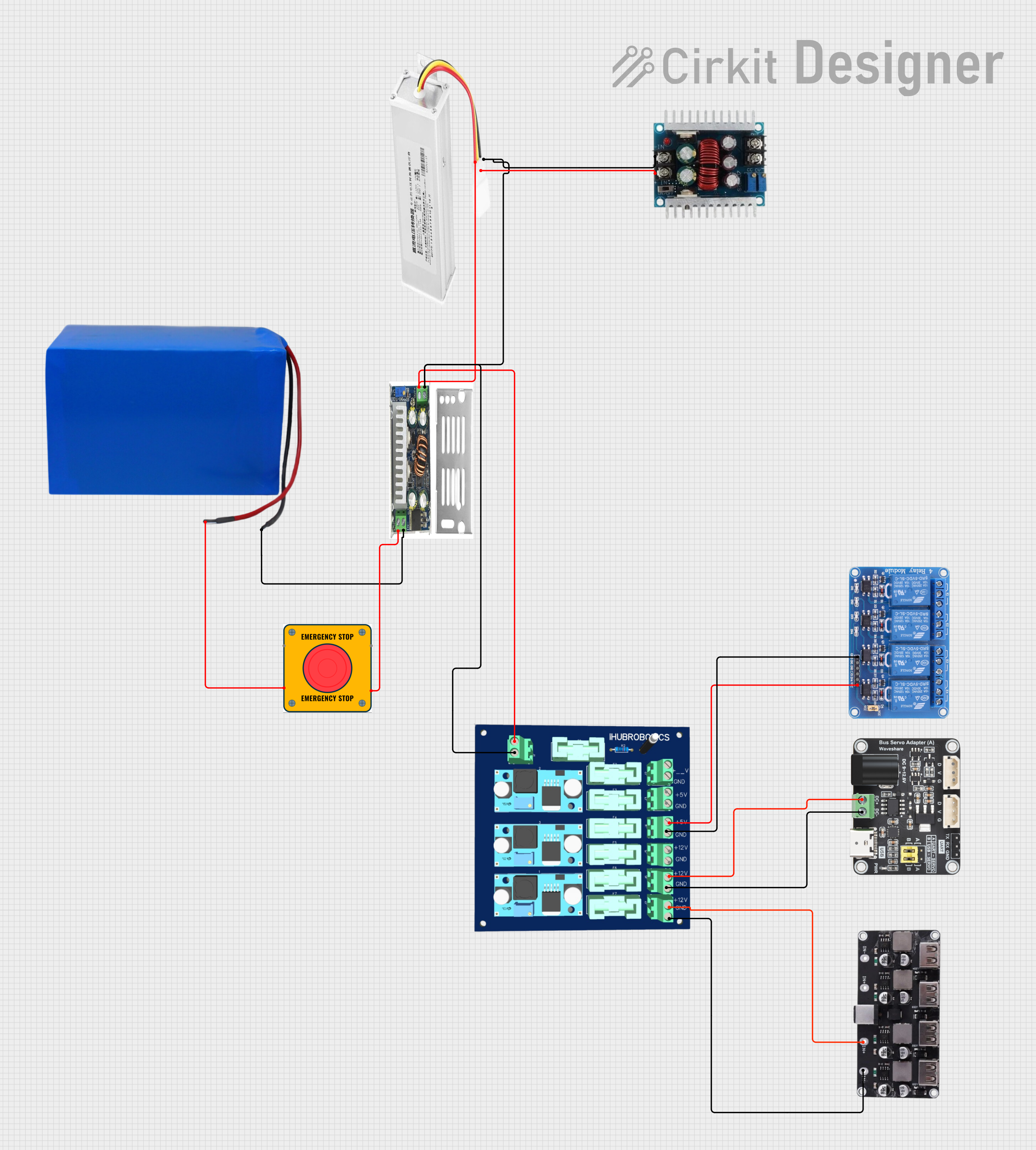
How to Use LM2596 DC-DC Step Down Converter: Examples, Pinouts, and Specs

 Design with LM2596 DC-DC Step Down Converter in Cirkit Designer
Design with LM2596 DC-DC Step Down Converter in Cirkit DesignerIntroduction
The LM2596 DC-DC Step Down Converter is a highly efficient voltage regulator designed to convert a higher DC input voltage to a lower, stable DC output voltage. It is widely used in power supply applications due to its high efficiency, compact size, and ease of use. This component is based on the LM2596 integrated circuit, which operates as a buck converter to step down voltage while maintaining a consistent output.
Explore Projects Built with LM2596 DC-DC Step Down Converter

 Open Project in Cirkit Designer
Open Project in Cirkit Designer
 Open Project in Cirkit Designer
Open Project in Cirkit Designer
 Open Project in Cirkit Designer
Open Project in Cirkit Designer
 Open Project in Cirkit Designer
Open Project in Cirkit DesignerExplore Projects Built with LM2596 DC-DC Step Down Converter

 Open Project in Cirkit Designer
Open Project in Cirkit Designer
 Open Project in Cirkit Designer
Open Project in Cirkit Designer
 Open Project in Cirkit Designer
Open Project in Cirkit Designer
 Open Project in Cirkit Designer
Open Project in Cirkit DesignerCommon Applications and Use Cases
- Powering low-voltage devices from higher-voltage sources (e.g., 12V to 5V conversion)
- Battery-powered systems to regulate voltage
- Embedded systems and microcontroller projects
- LED drivers and lighting systems
- DIY electronics and prototyping
Technical Specifications
The LM2596 DC-DC Step Down Converter has the following key specifications:
| Parameter | Value |
|---|---|
| Input Voltage Range | 4.5V to 40V |
| Output Voltage Range | 1.23V to 37V (adjustable via potentiometer) |
| Output Current | Up to 3A |
| Efficiency | Up to 92% |
| Switching Frequency | 150 kHz |
| Operating Temperature | -40°C to +125°C |
| Dimensions | Typically 45mm x 20mm x 14mm |
Pin Configuration and Descriptions
The LM2596 DC-DC Step Down Converter module typically has the following pinout:
| Pin Name | Description |
|---|---|
| VIN | Input voltage pin (connect to the higher DC voltage) |
| GND | Ground pin (common ground for input and output) |
| VOUT | Output voltage pin (provides the regulated lower voltage) |
Usage Instructions
How to Use the LM2596 in a Circuit
Connect the Input Voltage (VIN):
- Attach the positive terminal of your DC power source to the
VINpin. - Connect the negative terminal of your power source to the
GNDpin.
- Attach the positive terminal of your DC power source to the
Adjust the Output Voltage:
- Use the onboard potentiometer to set the desired output voltage.
- Turn the potentiometer clockwise to increase the output voltage or counterclockwise to decrease it.
- Use a multimeter to measure the output voltage at the
VOUTpin while adjusting.
Connect the Load:
- Attach the positive terminal of your load to the
VOUTpin. - Connect the negative terminal of your load to the
GNDpin.
- Attach the positive terminal of your load to the
Power On:
- Turn on the input power source. The module will regulate the input voltage to the desired output voltage.
Important Considerations and Best Practices
- Input Voltage: Ensure the input voltage is within the specified range (4.5V to 40V). Exceeding this range may damage the module.
- Output Current: Do not exceed the maximum output current of 3A. Use a heatsink if operating near the maximum current for extended periods.
- Voltage Adjustment: Always measure the output voltage with a multimeter when adjusting the potentiometer to avoid overvoltage to your load.
- Polarity: Double-check the polarity of your connections. Reversing the input voltage can damage the module.
- Filtering Capacitors: For optimal performance, use external capacitors on the input and output to reduce noise and ripple.
Example: Using LM2596 with Arduino UNO
The LM2596 can be used to power an Arduino UNO by stepping down a 12V input to 5V. Below is an example circuit and code:
Circuit Connections
- Connect a 12V DC power source to the
VINandGNDpins of the LM2596. - Adjust the potentiometer to set the output voltage to 5V.
- Connect the
VOUTpin of the LM2596 to the 5V pin of the Arduino UNO. - Connect the
GNDpin of the LM2596 to the GND pin of the Arduino UNO.
Example Code
// Example code to blink an LED using Arduino UNO powered by LM2596
// Ensure the LM2596 output is set to 5V before connecting to the Arduino
const int ledPin = 13; // Pin connected to the onboard LED
void setup() {
pinMode(ledPin, OUTPUT); // Set the LED pin as an output
}
void loop() {
digitalWrite(ledPin, HIGH); // Turn the LED on
delay(1000); // Wait for 1 second
digitalWrite(ledPin, LOW); // Turn the LED off
delay(1000); // Wait for 1 second
}
Troubleshooting and FAQs
Common Issues and Solutions
No Output Voltage:
- Check the input voltage to ensure it is within the specified range.
- Verify all connections, especially the polarity of the input and output.
- Ensure the potentiometer is not set to the minimum output voltage (1.23V).
Output Voltage is Incorrect:
- Use a multimeter to measure the output voltage and adjust the potentiometer as needed.
- Ensure the load does not exceed the module's current rating.
Module Overheating:
- Check if the load current exceeds 3A. Reduce the load or add a heatsink to the module.
- Ensure proper ventilation around the module.
High Output Ripple or Noise:
- Add external capacitors (e.g., 100µF electrolytic and 0.1µF ceramic) to the input and output pins.
- Ensure the input power source is stable and free of noise.
FAQs
Q: Can the LM2596 be used to power a Raspberry Pi?
A: Yes, the LM2596 can step down a 12V input to 5V to power a Raspberry Pi. However, ensure the output voltage is precisely set to 5V and the current demand does not exceed 3A.
Q: Is the LM2596 suitable for battery-powered applications?
A: Yes, the LM2596 is ideal for battery-powered systems as it efficiently regulates voltage with minimal power loss.
Q: Can I use the LM2596 to step up voltage?
A: No, the LM2596 is a step-down (buck) converter and cannot increase the input voltage. For step-up applications, use a boost converter.
Q: How do I reduce heat generation in the module?
A: Operate the module below its maximum current rating, use a heatsink, and ensure proper airflow around the module.
This concludes the documentation for the LM2596 DC-DC Step Down Converter.